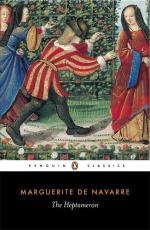the partial toleration of religious liberty which for
a time distinguished his reign. It was not till
her influence was weakened that intolerance prevailed,
and she was able even then for a time to save Marot
and other distinguished persons from persecution.
It is rather a moot-point how far she inclined to
the Reformed doctrines, properly so called. Her
letters, her serious and poetical work, and even the
Heptameron itself, show a fervently pietistic
spirit, and occasionally seem to testify to a distinct
inclination towards Protestantism, which is also positively
attested by Brantome and others; but this Protestantism
must have been, so far as it was consistent and definite
at all, the Protestantism of Erasmus rather than of
Luther, of Rabelais rather than of Calvin. She
had a very strong objection to the coarseness, the
vices, the idleness, the brutish ignorance of the
cloister; she had aspirations after a more spiritual
form of religion than the ordinary Catholicism of
her day provided, and as a strong politician she may
have had something of that Gallicanism which has always
been well marked in some of the best Frenchmen, and
which at one time nearly prevailed with her great-great-grandson,
Louis XIV. But there is no doubt that, as her
brother said to the fanatical Montmorency, she would
always have been and always was of his religion, the
religion of the State. The side of the Reformation
which must have most appealed to her was neither its
austere morals, nor its bare ritual, nor its doctrines,
properly so called, but its spiritual pietism and
its connection with profane learning and letters; for
of literature Margaret was an ardent devotee and a
constant practitioner.
Her best days were done by the time of her second
marriage. After the King’s return from
Spain persecution broke out, and Margaret’s influence
became more and more weak to stop it. As early
as 1533 her own Miroir de l’Ame Pecheresse,
then in a second edition, provoked the fanaticism
of the Sorbonne, and the King had to interfere in person
to protect his sister’s work and herself from
gross insult. The Medici marriage increased the
persecuting tendency, and for a time there was even
an attempt to suppress printing, and with it all that
new literature which was the Queen’s delight.
She was herself in some danger, but Francis had not
sunk so low as to permit any actual attack to be made
on her. Yet all the last years of her life were
unhappy, though she continued to keep Court at Nerac
in Pau, to accompany her brother in his progresses,
and, as we know from documents, to play Lady Bountiful
over a wide area of France. Her husband appears
to have been rather at variance with her; and her
daughter, who married first, and in name only, the
Duke of Cleves in 1540, and later (1548) Anthony de
Bourbon, was also not on cordial terms with her mother.
By the date of this second marriage Francis was dead,
and though he had for many years been anything but




